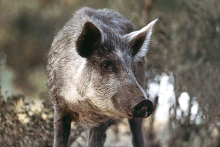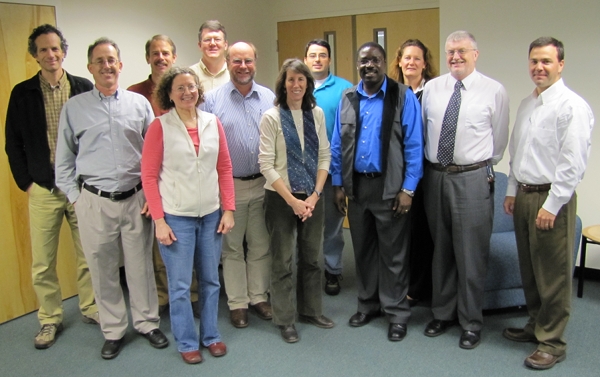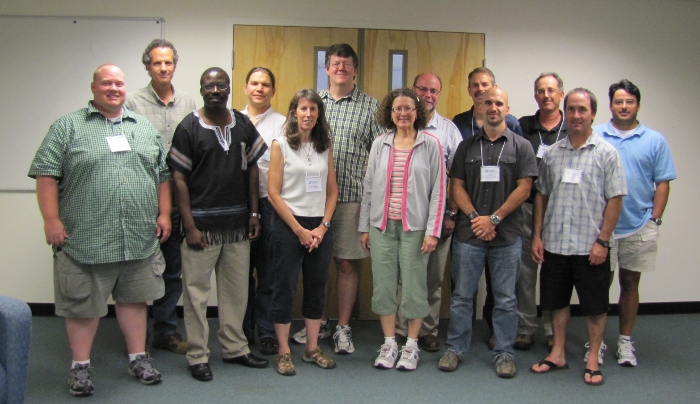| Description | Participants | Summaries | Products | Feature |
|---|
Archived NIMBioS Working Group
Feral Swine/Pseudo-rabies in Great Smoky Mountains National Park

Topic: Working Group on feral swine / pseudo-rabies in Great Smoky Mountains National Park
Meeting dates: Apr. 27-29, 2009; Jan. 25-26, 2010; Aug. 10-12, 2010; Aug. 15-16, 2011
Organizers:
Graham Hickling (Dept. of Forestry, Wildlife and Fisheries, Institute of Agriculture, Univ. of Tennessee, Knoxville; Director, Center for Wildlife Health)
Suzanne Lenhart (Mathematics Dept., Univ. of Tennessee, Knoxville)
Les Real (Biology Dept., Emory Univ., Atlanta, Georgia)
Objectives: A theme of particular interest to NIMBioS’ sponsoring agencies is the enhancement of capacity to analyze and manage outbreaks of disease among wild animals and domestic herds. To address this theme, we are convening a Working Group on the problem of managing pseudo-rabies virus (PRV) and other disease agents among feral swine within Great Smoky Mountains National Park (GSMNP).
Feral swine have been managed in GSMNP for many years in response to the habitat damage they cause – they are now a focus of increased attention since the detection in 2005 of individuals infected with pseudo-rabies virus (PRV). Pseudo-rabies has almost certainly arrived in the Park as a consequence of hunters’ illegal releases of swine from quarantined states into either the Park or into the immediately adjacent National Forest land.
PRV is of great concern in North Carolina due to the large economic impact that would arise if swine exports from the State were quarantined as a consequence of spillover from feral swine from GSMNP. This situation provides a useful focus for our Working Group to address general issues of wildlife population management tied to spatial disease spread, and determining the optimal balance of effort between surveillance and control activities.
The Working Group’s aim is to develop a modeling approach that can incorporate what we know about feral pig movement, interaction and PRV transmission with what if scenarios relating to available management options (culling, fencing, vaccination of adjacent livestock) that Park managers could consider. Further, the modeling approaches adopted will aim to provide a sufficiently general framework to be a useful starting-point for similar problems in other parks and wildland areas in later years. Our intention is that the Working Group’s outputs be to the greatest extent possible transferable to other wildlife-livestock interface disease problems.
The extensive outreach opportunities to the general public provided by the National Park Service interpreters provide an opportunity to broaden public appreciation of the utility of these kinds of quantitative approaches in addressing issues of national concern related to natural system management. This Working Group also provides opportunities to strengthen connections with NIMBioS’ formal partners, particularly Oak Ridge National Laboratory, and Great Smoky Mountains National Park.

Meeting Summaries
| Mtg # | Dates | Agenda | Summary | Photo | Evaluation |
|---|---|---|---|---|---|
| 1 | Apr 27-29, 2009 | Link | Report | ||
| 2 | Jan 25-26, 2010 | Link | Link | Report | |
| 3 | Aug 10-12, 2010 | Link | Report | ||
| 4 | Aug 15-16, 2011 | Link | Link |
Meeting 1 Summary. This group is investigating optimal management of feral hogs in the GSMNP and the spread of pseudorabies in these hogs using control measures with spatial and temporal features. Recent data on hogs and pseudorabies in the GSMNP were discussed. The group then reviewed the growing distribution of feral hogs across the United States, as captured by the National Feral Swine Mapping system. Key tasks for the group were assigned, including:
- initiating modeling of the feral hog population in the GSMNP,
- investigating prospects for predicting the spread of feral hogs in the southeastern United States, and
- reviewing the general principles of modeling and management of emerging diseases in feral species.
Meeting 2 Summary. The second meeting began with an update on control efforts and disease surveillance of GSMNP hogs over the past year (Stiver). We then discussed the development and availability of geospatial datasets for the GSMNP (Madden) and a preliminary spatial model for population dynamics and movement of hogs within and adjacent to the park (Lenhart). Progress on nationwide mapping of feral hog distribution was reviewed (Corn). The University of Georgia has been developing a "cyber-infrastructure" proposal to the NSF for mapping and analysis of multiple invasive species, and our Working Group is collaborating on the feral hog component of that initiative.
A preliminary spatial model for the future spread of feral hogs in the southeastern U.S. was presented (Hickling, Collins and Carr), using Arkansas data as a case study to stimulate discussion on methodological approaches. The group then teleconferenced with Dr. Les Real to discuss opportunities for collaboration with RAPIDD (an NIH/DHS-sponsored disease modeling initiative, led by Bryan Grenfell). In March, RAPIDD is forming a working group to consider wildlife-livestock-human interface diseases, including several Foreign Animal Diseases spread by feral hogs.
Prospects for a review paper on the role of modeling in developing management strategies for control of disease in feral hogs were discussed (McCallum), and the significance of feral hogs within the USDA’s overall pseudorabies virus eradication and surveillance program was reviewed (Kasari/Swofford).
Key tasks: a preliminary set of tasks developed by the working group at its first meeting were reviewed and revised:
- Construct a non-spatial age-structured model representing the transmission of pseudorabies in a ‘generic’ feral hog population.
- Construct a spatial model that incorporates seasonal (vegetation-driven, terrain-driven, mast-related?) movement of hogs in GSMNP.
- Adapt an existing Individual Based Movement (IBM) bear model so that it can be applied to feral hogs.
- Spatial/GIS modeling aimed at predict hog distribution 2016 in two pairs of states:
- Arkansas/Missouri
- North Carolina/South Carolina - A Risk Analysis that will investigate overlaying Wildlife Services’ and SCWDS’ feral hog pseudorabies data on feral hog distribution data.
- A review article on the role of modeling in developing strategies for management of disease in feral hogs, including impacts on livestock and native biodiversity.
- A model of short-timescale disease spread in feral hogs, in eastern U.S. environment, using Classical Swine Fever data
Meeting 3 Summary. The third meeting began with updates on progress of the group's four draft models, i.e., (1) a system of difference equations discrete in time and in space for the feral hog population in the GSMNP; (2) an individual-based model for feral hogs in the GSMNP; (3) a statistics-based spread model of feral hogs in Arkansas; and (4) a statistical analysis model of pseudorabies data in Arkansas. New group member Brandon Schmidt, who replaces Seth Swafford, presented an update on his USDA work related to feral hogs. The group then divided into subgroups to work on parameters and features to be included in Models 1, 2 and 3 above. Another subgroup worked on our review paper, Models for Disease Management in Feral Swine Populations. One paper has so far resulted from the work of this group, i.e., Smith GA, Mathematical model for the transmission of pseudorabies virus in feral swine populations in the USA. Submitted to Preventive Veterinary Medicine. We expect to have two further modeling papers and the review paper submitted by our next group meeting, which is scheduled for August 2011.
Meeting 4 Summary. This group is completing its work on modeling management of feral hogs in Great Smoky Mountains National Park, using an individual-based model and a discrete spatial-temporal model. The effects of harvesting on hog abundance and distribution is being investigated. The possible spread of pseudorabies virus among hogs in the park will be included. In addition, a statistical model has been constructed to investigate habitat factors contributing to the invasive spread of hog populations in the state of Arkansas, using known presence/absence data gathered at the University of Georgia. A review paper on the use of models to inform management of diseases in feral hogs is being written. Short talks were given on updates on the projects; the group then broke into two groups working on details for the papers listed below. A paper was submitted on a temporal model investigating different types of transmission pathways for pseudorabies and varying formats of force of infection.
 |
| Meeting 2 participants (Back row, L to R): Joe Corn, Graham Hickling, Kurt VerCauteren, Chuck Collins; (Front, L to R): Suzanne Lenhart, Hamish McCallum, Marguerite Madden, René Salinas, Agricola Odoi, Ellen Kasari, Gary Smith, Seth Swafford. Not Pictured: Bill Stiver |
 |
| Meeting 4 participants (Back row, L to R): Joe Corn, Eric Carr, Chuck Collins, René Salinas, Hamish McCallum, Graham Hickling, Kurt VerCauteren; (Front, L to R): Charles Anderson, Agricola Odoi, Marguerite Madden, Suzanne Lenhart, Joe Yarkovich, Brandon Schmit. Not pictured: Ellen Kasari, Gary Smith, Bill Stiver |
NIMBioS Working Groups are chosen to focus on major scientific questions at the interface between biology and mathematics. NIMBioS is particularly interested in questions that integrate diverse fields, require synthesis at multiple scales, and/or make use of or require development of new mathematical/computational approaches. NIMBioS Working Groups are relatively small (up to 10 participants), focus on a well-defined topic, and have well-defined goals and metrics of success. Working Groups will meet up to 3 times over a two-year period, with each meeting lasting up to 2.5 days.
A goal of NIMBioS is to enhance the cadre of researchers capable of interdisciplinary efforts across mathematics and biology. As part of this goal, NIMBioS is committed to promoting diversity in all its activities. Diversity is considered in all its aspects, social and scientific, including gender, ethnicity, scientific field, career stage, geography and type of home institution. Questions regarding diversity issues should be directed to diversity@nimbios.org. You can read more about our Diversity Plan on our NIMBioS Policies web page. The NIMBioS building is fully handicapped accessible.
NIMBioS
1122 Volunteer Blvd., Suite 106
University of Tennessee
Knoxville,
TN 37996-3410
PH: (865) 974-9334
FAX: (865) 974-9461
Contact NIMBioS


